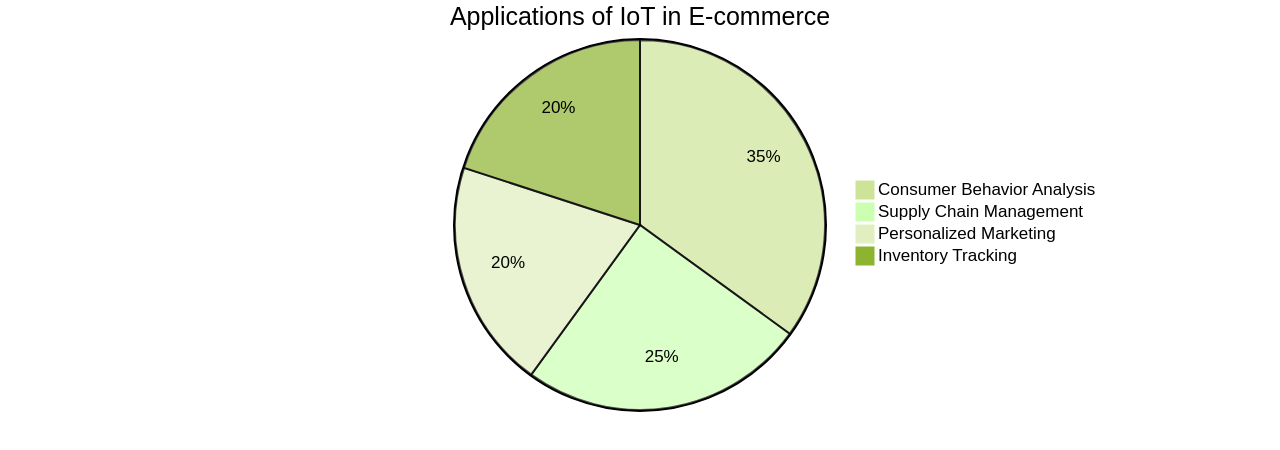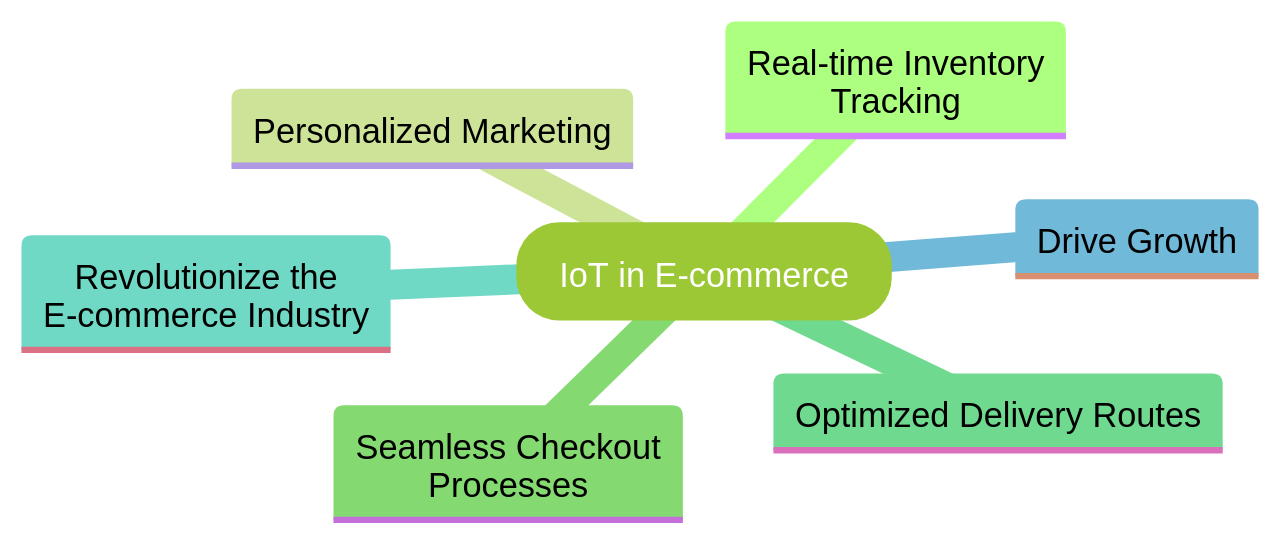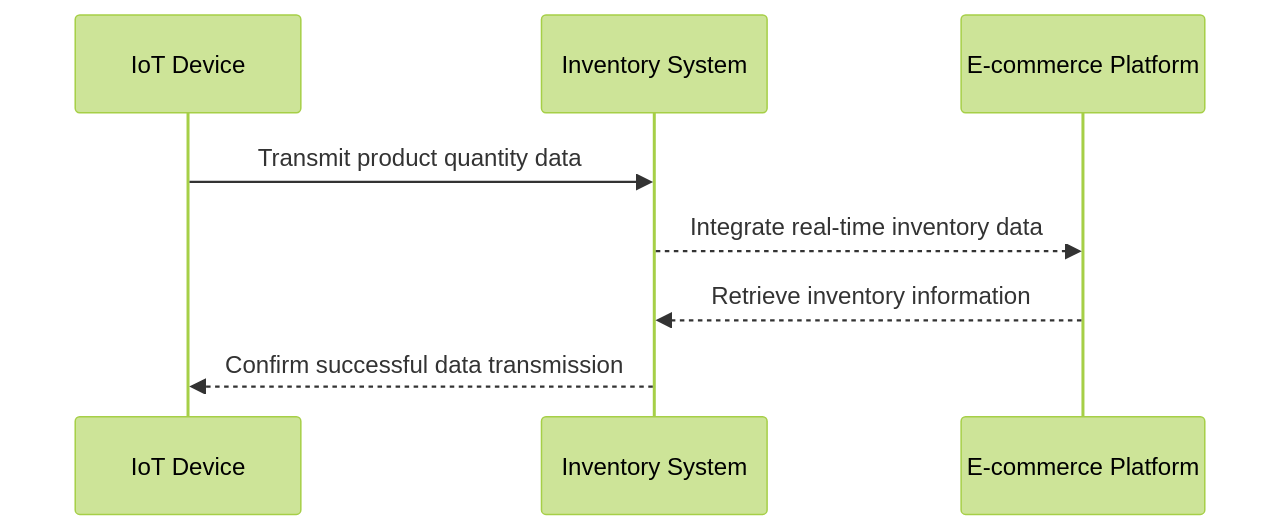Introduction
The intersection of e-commerce and the Internet of Things (IoT) has created a dynamic ecosystem where physical and digital realms seamlessly merge, with IoT devices playing a pivotal role. These devices generate a wealth of data that, when harnessed effectively, can significantly enhance e-commerce operations. By leveraging IoT data, businesses can gain insights into consumer behavior, personalize the customer experience, improve operational efficiency, and drive sales. In this article, we will explore the various applications of IoT in e-commerce, including real-time tracking and monitoring of goods, personalized marketing strategies, and the challenges and solutions in integrating IoT into e-commerce operations. We will also discuss successful case studies and future trends that highlight the transformative potential of IoT in shaping the future of e-commerce.
1. Understanding the Intersection of IoT and E-commerce
The intersection of e-commerce and the Internet of Things (IoT) has birthed a vibrant ecosystem where the physical and digital realms coalesce seamlessly, and IoT devices, from wearable technology to smart home appliances, play a pivotal role. These devices churn out a torrent of data that, when harnessed correctly, can significantly elevate e-commerce operations.
The goldmine of data generated by IoT devices is a veritable trove of insights into consumer behavior, preferences, and purchase patterns.

E-commerce businesses can use this information to fashion their offerings and marketing strategies to align with customer needs.
Align your offerings and marketing strategies with customer needs.
Additionally, IoT technologies can augment operational efficiency by automating a host of processes, limiting the need for manual intervention, and reducing the margin for errors.
IoT devices and sensors can be integrated into supply chain and logistics processes to enable real-time tracking and monitoring of goods, thereby boosting visibility and efficiency.
Boost visibility and efficiency with real-time tracking and monitoring of goods.
Additionally, e-commerce businesses can use IoT data to personalize the customer experience, by gathering data from connected devices and using it to provide targeted recommendations and promotions, thereby improving customer satisfaction and driving sales.
Various IoT applications can be employed for consumer behavior analysis in e-commerce.

These applications utilize IoT devices and sensors to collect real-time data on consumer interactions with e-commerce platforms, such as website browsing, product searches, and purchase behaviors. This data is then analyzed to gain insights into consumer preferences, shopping patterns, and decision-making processes, helping businesses tailor their marketing strategies, personalize user experiences, and optimize their product offerings to meet the specific needs and preferences of their target audience.
IoT technologies present numerous benefits in e-commerce operations, enabling businesses to gather and analyze real-time data, which can be used to optimize supply chain management, inventory tracking, and demand forecasting. IoT devices can also improve the customer experience by providing personalized recommendations, facilitating seamless checkout processes, and enabling real-time communication and support. Moreover, IoT technologies can aid in improving operational efficiency by automating various processes, reducing costs, and minimizing errors.
Successful case studies of implementing IoT in e-commerce have demonstrated how IoT devices and sensors can be utilized to optimize inventory management, streamline logistics and supply chain processes, enable real-time tracking and monitoring of products, and personalize the shopping experience for customers. By integrating IoT into e-commerce platforms, businesses have been able to gain valuable insights from data analytics, automate various tasks, and create innovative services that cater to the evolving needs of customers.
However, integrating IoT devices in e-commerce requires careful planning and implementation to ensure a seamless and secure user experience. Key factors to consider include data security, scalability, real-time analytics, seamless integration, customer engagement, and cross-channel integration.
IoT technologies offer a wealth of opportunities to improve operational efficiency in e-commerce.

For instance, RFID tags can be used to track inventory in real-time, ensuring accurate stock levels and reducing out-of-stock situations. Smart shelves can automatically monitor product levels and send notifications for reordering. IoT sensors can be used to monitor temperature and humidity in warehouses, ensuring optimal conditions for perishable goods. Additionally, IoT-enabled delivery vehicles can optimize routes and provide real-time updates to customers.
To use IoT data to personalize marketing strategies in e-commerce, it is crucial to gather relevant data from IoT devices and analyze it to gain insights about customer behavior and preferences. By leveraging IoT data, e-commerce businesses can create personalized marketing campaigns that target individual customers based on their specific needs and interests. This can be done by utilizing IoT data to understand customer preferences, purchase history, and browsing behavior, and then tailoring marketing messages and product recommendations accordingly. IoT data can also be used to track customer engagement and satisfaction with personalized marketing efforts, allowing e-commerce businesses to continuously refine and improve their strategies.
2. The Role of IoT in Streamlining E-commerce Operations
The integration of IoT in e-commerce operations has redefined the dynamics of the industry, facilitating an unprecedented level of efficiency and growth.

A crucial application of IoT is in real-time inventory management, where IoT sensors can be integrated into inventory systems. These sensors, strategically placed on shelves or storage areas, track product quantities in real-time, transmitting this invaluable data to a central system. This real-time data then feeds into e-commerce platforms, ensuring customers have accurate inventory information, thus enhancing customer satisfaction while minimizing the risk of stockouts.
IoT's capabilities extend beyond inventory management to maintaining the quality and integrity of products during storage and transit. IoT devices, equipped with sensors and network connectivity, collect and transmit real-time data about the product conditions. These conditions, which could include temperature, humidity, light exposure, and movement, offer businesses a comprehensive understanding of the product environment during storage and transit. By analyzing this data, businesses can identify potential issues or deviations from desired conditions, allowing for timely intervention and adjustments, thus minimizing losses and enhancing customer satisfaction.
IoT technologies also offer a new paradigm in personalized marketing in e-commerce. IoT devices collect a vast amount of data about customers' preferences, behaviors, and purchasing patterns, which can be used to create personalized marketing campaigns. Real-time tracking of customer interactions with products or services enables marketers to deliver personalized recommendations and offers at the right time, increasing conversion rates and customer satisfaction. Furthermore, IoT devices can provide valuable insights into customer engagement and satisfaction levels, enabling businesses to optimize their marketing strategies to better meet customer needs.
To further enhance the customer experience, IoT can be leveraged to improve product recommendations in e-commerce. By integrating IoT devices such as smart home assistants, wearable devices, and connected appliances, e-commerce platforms can gather real-time data on customer interactions, purchase history, and preferences. This data can then be used to personalize product recommendations, creating a more tailored shopping experience for customers.
IoT also plays a critical role in facilitating seamless, omnichannel shopping experiences. The expertise of software developers, designers, and engineers can be leveraged to craft innovative solutions catering to specific needs and questions. Companies like BestToolbars.net offer access to top-tier talent and provide valuable insights and advice. They can assist with initial project research, bug fixes, and market alignment, speeding up the development process and ensuring the successful implementation of IoT solutions in e-commerce operations.
There are several case studies that illustrate the successful implementation of IoT in e-commerce. These include the use of IoT sensors in warehouses for real-time inventory tracking and optimization of stock replenishment, the use of IoT-enabled smart shelves to monitor product availability and pricing in real-time, and the use of IoT devices in delivery vehicles to track the location and condition of packages in transit. These examples showcase how businesses can leverage IoT to streamline their supply chain, enhance inventory management, and improve overall customer satisfaction in the e-commerce space.
In conclusion, the use of IoT in e-commerce operations can significantly enhance operational efficiency, improve customer satisfaction, and drive revenue growth. By embracing IoT, businesses can stay ahead of the curve in the competitive e-commerce industry.
3. Case Studies: Successful Implementation of IoT in E-commerce
Numerous e-commerce ventures have tapped into the potential of IoT technologies to bolster their operations. Take Amazon for example, where IoT has been introduced into the warehouse environment to modernize inventory management and fine-tune order fulfillment processes. They have employed IoT-empowered robots for the purpose of fetching items from shelves and transporting them to packing stations, thereby boosting efficiency and minimizing errors.
In a similar vein, Walmart has harnessed the power of IoT for real-time inventory management and to refine in-store customer experiences. They have put IoT sensors to work, monitoring stock levels on shelves and automatically reordering products when required.
These case studies shed light on the immense potential of IoT in augmenting e-commerce operations and driving growth. The successful implementation of IoT in these e-commerce giants demonstrates the ability of IoT to enhance operational efficiency, improve customer experience, and foster business growth. It's clear to see how IoT devices and sensors can be put to use to optimize inventory management, streamline logistics and supply chain processes, enable real-time tracking and monitoring of products, and personalize the shopping experience for customers.
For instance, the integration of IoT sensors with the e-commerce platform allows businesses to track their inventory in real-time and make informed decisions about restocking and order fulfillment, improving efficiency and customer satisfaction in the e-commerce supply chain.
Furthermore, by integrating IoT devices such as sensors, RFID tags, and smart shelves, Amazon is able to track inventory levels in real-time, automate inventory replenishment, and optimize warehouse operations. This allows Amazon to gather valuable data about the movement of products within their warehouses, which can then be used to improve efficiency, reduce errors, and enhance the overall order fulfillment process.
In the case of Walmart, they leverage IoT devices and sensors to track inventory levels in real-time. By connecting these devices to their inventory management system, Walmart can monitor stock levels, automatically reorder products when they reach a certain threshold, and optimize their supply chain operations. This helps Walmart ensure that their shelves are always stocked with the right products, reducing out-of-stock situations and improving overall customer satisfaction.
Moreover, IoT technology can also be used to enhance the customer experience at Walmart. IoT-enabled devices such as smart shelves can provide customers with real-time product information, pricing, and promotions. Additionally, IoT devices can enable personalized recommendations and offers based on customer preferences and shopping history, creating a more tailored and engaging shopping experience.
The integration of IoT devices and technologies into e-commerce operations allows businesses to automate inventory management, optimize supply chain logistics, monitor product quality and safety, and personalize customer interactions. IoT applications also enable real-time data collection and analysis, allowing businesses to make data-driven decisions and improve overall operational performance in the e-commerce sector.
The e-commerce industry has experienced significant growth due to the implementation of IoT-driven technologies. These technologies have revolutionized the way consumers interact with online platforms, enabling a seamless and personalized shopping experience. With IoT devices such as smart speakers, wearables, and smart home appliances, retailers can gather valuable data on consumer behavior and preferences. This data can be used to optimize product recommendations, personalize marketing campaigns, and improve supply chain management. Furthermore, IoT-driven solutions have enhanced inventory management, enabling real-time tracking of products and automating replenishment processes. As a result, e-commerce businesses can provide faster and more efficient delivery services, increasing customer satisfaction and loyalty.
In conclusion, the integration of IoT in the e-commerce industry has paved the way for substantial growth and innovation. The implementation of IoT in e-commerce businesses can provide numerous benefits. By integrating IoT devices and sensors into the e-commerce infrastructure, businesses can gain real-time insights into inventory management, supply chain optimization, and customer behavior. This enables businesses to streamline their operations, reduce costs, and enhance the overall customer experience. Additionally, IoT can enable personalized marketing and targeted promotions based on individual customer preferences and purchasing patterns. Overall, implementing IoT in e-commerce businesses can lead to increased efficiency, improved decision-making, and a competitive edge in the market.
4. Challenges and Solutions in Integrating IoT into E-commerce
Integrating IoT into e-commerce operations, while laden with potential, can also present a unique set of challenges.

These range from data security and privacy concerns, interoperability issues, as well as the need for substantial investment in IoT infrastructure. However, by adhering to certain strategies, these hurdles can be effectively managed.
One of the key strategies is to identify the relevant use cases where IoT can add value to e-commerce operations. This involves considering areas such as inventory management, supply chain optimization, personalized marketing, and customer experience enhancement.
Selecting the right IoT devices and sensors that are compatible with the e-commerce infrastructure and meet specific operational requirements is another crucial step. These devices should provide accurate data and integrate seamlessly with existing systems.
Data security is paramount when IoT devices are involved as they collect and transmit sensitive data. Implementing robust security measures like data encryption, regular firmware updates, and access controls can protect against unauthorized access or data breaches.
Establishing a reliable network infrastructure that can handle the increased data traffic and provide seamless connectivity across e-commerce operations is essential for the smooth functioning of IoT devices. The IoT data collected should be integrated with analytics tools to gain actionable insights that can drive better decision-making and optimize e-commerce operations.
Automation and AI technologies should be leveraged to process and analyze IoT data in real-time, helping to streamline operations, improve efficiency, and enable predictive maintenance. Regular monitoring and maintenance of IoT devices ensures they are functioning optimally and prevents device failures and downtime.
Implementing encryption protocols and strong authentication methods, such as two-factor authentication, can enhance the protection of customer data and ensure a secure IoT implementation. Organizations should also comply with relevant privacy regulations to build trust with customers and maintain the security of their data in the IoT environment.
To ensure seamless connectivity between IoT devices and the e-commerce platform, standardized protocols and APIs can be used for easy communication and data exchange. Further, data analytics and machine learning algorithms can be used to analyze the vast amount of data generated by IoT devices, providing valuable insights into customer behavior, preferences, and trends. This information can then be used to personalize the shopping experience, improve product recommendations, and optimize supply chain management.
Collaboration and partnerships with IoT device manufacturers and service providers can help overcome integration challenges. By working together, e-commerce companies can gain access to the latest IoT technologies, receive technical support, and ensure compatibility and interoperability between different devices and platforms.
In conclusion, integrating IoT into e-commerce operations can be a complex task, but with careful planning, adherence to best practices, and collaboration with experienced IoT solution providers, businesses can unlock the full potential of this transformative technology.
5. Future Trends: How IoT is Shaping the Future of E-commerce
IoT technologies are paving the way for the future of e-commerce. One key trend is voice commerce, enabled by IoT devices such as smart speakers like Amazon Echo or Google Home, and wearable devices like smartwatches. These devices, embedded with voice assistants like Alexa or Google Assistant, allow users to make purchases using simple voice commands.
IoT is also playing a crucial role in personalized marketing. By collecting data from devices such as wearables, beacons, and smart home devices, businesses can gain valuable insights into customer behavior and preferences. This data can be used to send targeted promotions or personalized recommendations, creating a bespoke shopping experience for each customer.
Moreover, the integration of IoT with AI and AR technologies is enhancing customer experience in e-commerce. IoT devices such as smart shelves, beacons, and wearables can collect real-time data on customer behavior, preferences, and product usage. This data can be processed by AI algorithms to provide personalized recommendations, optimize inventory levels, and enable predictive maintenance. AI-powered chatbots and virtual assistants further enhance customer support and provide personalized shopping experiences. AR technology allows customers to visualize products in their real environment before making a purchase, helping them make more informed decisions.
The advent of 5G technology is set to enhance IoT connectivity in e-commerce significantly. The high-speed, low-latency capabilities of 5G networks enable faster data transfer and processing, leading to enhanced efficiency and productivity in e-commerce operations. The increased bandwidth and network capacity offered by 5G technology allow for a greater number of IoT devices to be connected simultaneously, streamlining operations and providing a seamless customer experience.
To fully leverage IoT in e-commerce, businesses need to follow several best practices. These include focusing on personalization, optimizing inventory management, ensuring secure and seamless transactions, and leveraging IoT analytics to gain insights and make data-driven decisions. These practices will help e-commerce businesses effectively utilize IoT to enhance customer experiences, optimize operations, and drive business growth.
Conclusion
In conclusion, the intersection of e-commerce and the Internet of Things (IoT) has revolutionized the way businesses operate in the digital landscape. By leveraging IoT data, businesses can gain valuable insights into consumer behavior, personalize marketing strategies, improve operational efficiency, and drive sales. IoT devices and sensors enable real-time tracking and monitoring of goods, personalized marketing campaigns, and optimization of supply chain management. Successful case studies have demonstrated the transformative potential of IoT in streamlining inventory management, enhancing customer experiences, and improving overall operational performance in e-commerce. However, integrating IoT into e-commerce operations requires careful planning and consideration of factors such as data security, scalability, real-time analytics, seamless integration, customer engagement, and cross-channel integration. To stay ahead in the competitive e-commerce industry, businesses should embrace IoT technologies and leverage their capabilities to enhance efficiency and customer satisfaction.
To harness the benefits of IoT in e-commerce today start now





